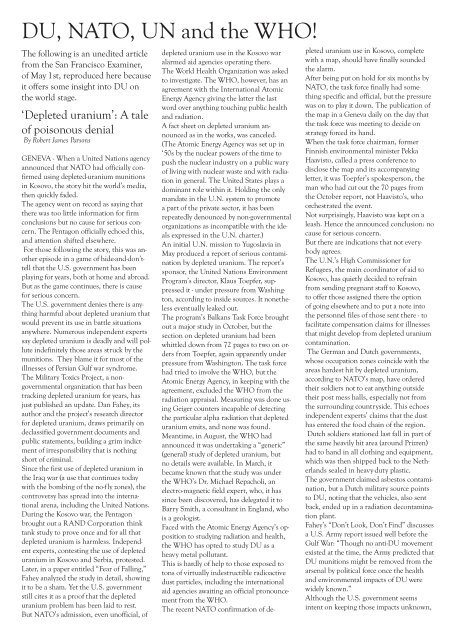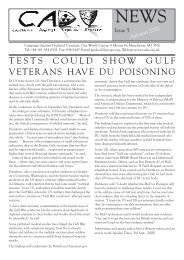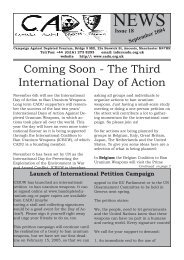CADU News 4 - Campaign Against Depleted Uranium
CADU News 4 - Campaign Against Depleted Uranium
CADU News 4 - Campaign Against Depleted Uranium
Create successful ePaper yourself
Turn your PDF publications into a flip-book with our unique Google optimized e-Paper software.
DU, NATO, UN and the WHO!<br />
The following is an unedited article<br />
from the San Francisco Examiner,<br />
of May 1st, reproduced here because<br />
it offers some insight into DU on<br />
the world stage.<br />
‘<strong>Depleted</strong> uranium’: A tale<br />
of poisonous denial<br />
By Robert James Parsons<br />
GENEVA - When a United Nations agency<br />
announced that NATO had officially confirmed<br />
using depleted-uranium munitions<br />
in Kosovo, the story hit the world’s media,<br />
then quickly faded.<br />
The agency went on record as saying that<br />
there was too little information for firm<br />
conclusions but no cause for serious concern.<br />
The Pentagon officially echoed this,<br />
and attention shifted elsewhere.<br />
For those following the story, this was another<br />
episode in a game of hide-and-don’ttell<br />
that the U.S. government has been<br />
playing for years, both at home and abroad.<br />
But as the game continues, there is cause<br />
for serious concern.<br />
The U.S. government denies there is anything<br />
harmful about depleted uranium that<br />
would prevent its use in battle situations<br />
anywhere. Numerous independent experts<br />
say depleted uranium is deadly and will pollute<br />
indefinitely those areas struck by the<br />
munitions. They blame it for most of the<br />
illnesses of Persian Gulf war syndrome.<br />
The Military Toxics Project, a nongovernmental<br />
organization that has been<br />
tracking depleted uranium for years, has<br />
just published an update. Dan Fahey, its<br />
author and the project’s research director<br />
for depleted uranium, draws primarily on<br />
declassified government documents and<br />
public statements, building a grim indictment<br />
of irresponsibility that is nothing<br />
short of criminal.<br />
Since the first use of depleted uranium in<br />
the Iraq war (a use that continues today<br />
with the bombing of the no-f ly zones), the<br />
controversy has spread into the international<br />
arena, including the United Nations.<br />
During the Kosovo war, the Pentagon<br />
brought out a R AND Corporation think<br />
tank study to prove once and for all that<br />
depleted uranium is harmless. Independent<br />
experts, contesting the use of depleted<br />
uranium in Kosovo and Serbia, protested.<br />
Later, in a paper entitled “Fear of Falling,”<br />
Fahey analyzed the study in detail, showing<br />
it to be a sham. Yet the U.S. government<br />
still cites it as a proof that the depleted<br />
uranium problem has been laid to rest.<br />
But NATO’s admission, even unofficial, of<br />
depleted uranium use in the Kosovo war<br />
alarmed aid agencies operating there.<br />
The World Health Organization was asked<br />
to investigate. The WHO, however, has an<br />
agreement with the International Atomic<br />
Energy Agency giving the latter the last<br />
word over anything touching public health<br />
and radiation.<br />
A fact sheet on depleted uranium announced<br />
as in the works, was canceled.<br />
(The Atomic Energy Agency was set up in<br />
‘50s by the nuclear powers of the time to<br />
push the nuclear industry on a public wary<br />
of living with nuclear waste and with radiation<br />
in general. The United States plays a<br />
dominant role within it. Holding the only<br />
mandate in the U.N. system to promote<br />
a part of the private sector, it has been<br />
repeatedly denounced by non-governmental<br />
organizations as incompatible with the ideals<br />
expressed in the U.N. charter.)<br />
An initial U.N. mission to Yugoslavia in<br />
May produced a report of serious contamination<br />
by depleted uranium. The report’s<br />
sponsor, the United Nations Environment<br />
Program’s director, Klaus Toepfer, suppressed<br />
it - under pressure from Washington,<br />
according to inside sources. It nonetheless<br />
eventually leaked out.<br />
The program’s Balkans Task Force brought<br />
out a major study in October, but the<br />
section on depleted uranium had been<br />
whittled down from 72 pages to two on orders<br />
from Toepfer, again apparently under<br />
pressure from Washington. The task force<br />
had tried to involve the WHO, but the<br />
Atomic Energy Agency, in keeping with the<br />
agreement, excluded the WHO from the<br />
radiation appraisal. Measuring was done using<br />
Geiger counters incapable of detecting<br />
the particular alpha radiation that depleted<br />
uranium emits, and none was found.<br />
Meantime, in August, the WHO had<br />
announced it was undertaking a “generic”<br />
(general) study of depleted uranium, but<br />
no details were available. In March, it<br />
became known that the study was under<br />
the WHO’s Dr. Michael Repacholi, an<br />
electro-magnetic field expert, who, it has<br />
since been discovered, has delegated it to<br />
Barry Smith, a consultant in England, who<br />
is a geologist.<br />
Faced with the Atomic Energy Agency’s opposition<br />
to studying radiation and health,<br />
the WHO has opted to study DU as a<br />
heavy metal pollutant.<br />
This is hardly of help to those exposed to<br />
tons of virtually indestructible radioactive<br />
dust particles, including the international<br />
aid agencies awaiting an official pronouncement<br />
from the WHO.<br />
The recent NATO confirmation of depleted<br />
uranium use in Kosovo, complete<br />
with a map, should have finally sounded<br />
the alarm.<br />
After being put on hold for six months by<br />
NATO, the task force finally had something<br />
specific and official, but the pressure<br />
was on to play it down. The publication of<br />
the map in a Geneva daily on the day that<br />
the task force was meeting to decide on<br />
strategy forced its hand.<br />
When the task force chairman, former<br />
Finnish environmental minister Pekka<br />
Haavisto, called a press conference to<br />
disclose the map and its accompanying<br />
letter, it was Toepfer’s spokesperson, the<br />
man who had cut out the 70 pages from<br />
the October report, not Haavisto’s, who<br />
orchestrated the event.<br />
Not surprisingly, Haavisto was kept on a<br />
leash. Hence the announced conclusion: no<br />
cause for serious concern.<br />
But there are indications that not everybody<br />
agrees.<br />
The U.N.’s High Commissioner for<br />
Refugees, the main coordinator of aid to<br />
Kosovo, has quietly decided to refrain<br />
from sending pregnant staff to Kosovo,<br />
to offer those assigned there the option<br />
of going elsewhere and to put a note into<br />
the personnel files of those sent there - to<br />
facilitate compensation claims for illnesses<br />
that might develop from depleted uranium<br />
contamination.<br />
The German and Dutch governments,<br />
whose occupation zones coincide with the<br />
areas hardest hit by depleted uranium,<br />
according to NATO’s map, have ordered<br />
their soldiers not to eat anything outside<br />
their post mess halls, especially not from<br />
the surrounding countryside. This echoes<br />
independent experts’ claims that the dust<br />
has entered the food chain of the region.<br />
Dutch soldiers stationed last fall in part of<br />
the same heavily hit area (around Prizren)<br />
had to hand in all clothing and equipment,<br />
which was then shipped back to the Netherlands<br />
sealed in heavy-duty plastic.<br />
The government claimed asbestos contamination,<br />
but a Dutch military source points<br />
to DU, noting that the vehicles, also sent<br />
back, ended up in a radiation decontamination<br />
plant.<br />
Fahey’s “Don’t Look, Don’t Find” discusses<br />
a U.S. Army report issued well before the<br />
Gulf War: “Though no anti-DU movement<br />
existed at the time, the Army predicted that<br />
DU munitions might be removed from the<br />
arsenal by political force once the health<br />
and environmental impacts of DU were<br />
widely known.”<br />
Although the U.S. government seems<br />
intent on keeping those impacts unknown,





